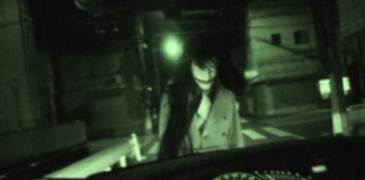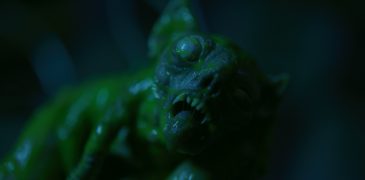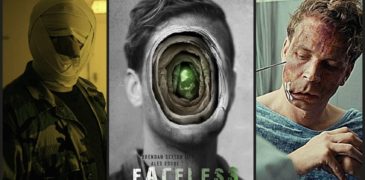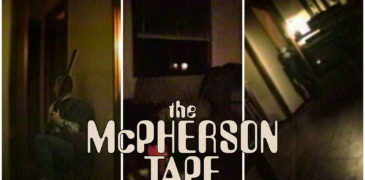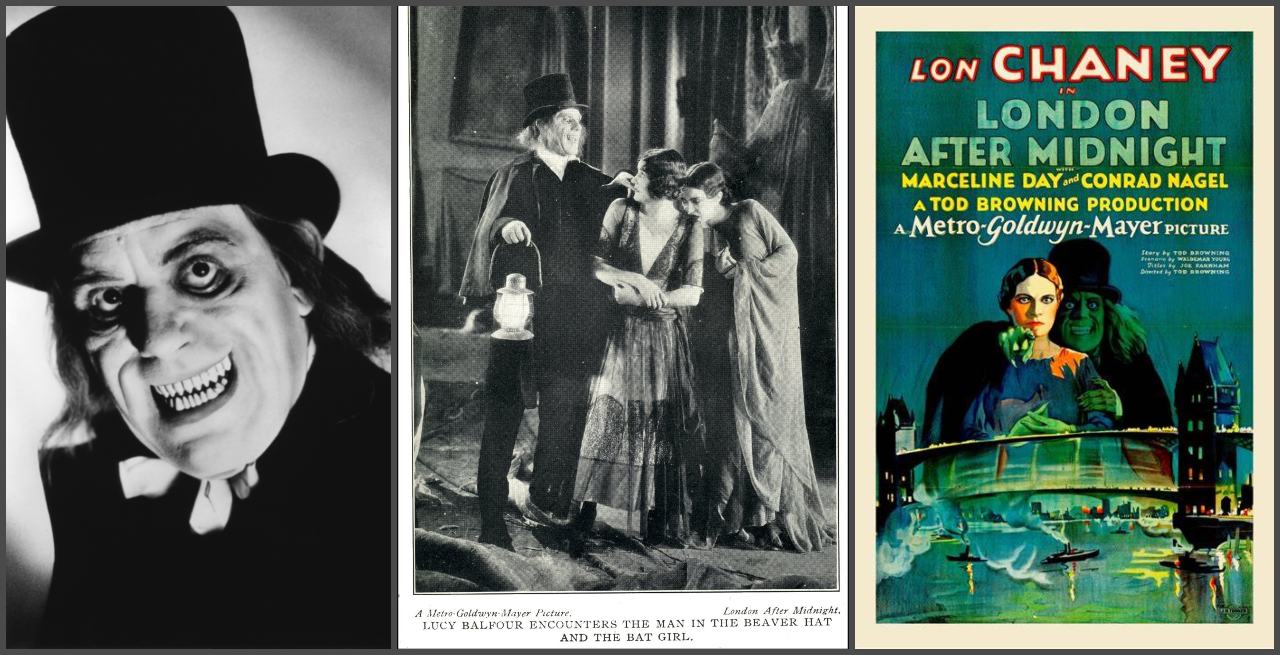
The era of silent and pre-code horror was different. In the interim between the invention of the film and the implementation of the Production Code (in 1934), films had little oversight or censorship. They often depicted extreme violence, sexually graphic content, homosexuality, and things otherwise deemed “vulgar” by the Production Code Administration.
Unfortunately, many of these films were lost over the years. One major event was the 1965 MGM vault fire, in which hundreds of films were destroyed. Since the fire, many film buffs have attempted to track down alternate versions of films, or even reconstruct them based on scripts and stills. Of these, perhaps the most sought after is London After Midnight. Despite being mostly destroyed in the fire, it has maintained a strong cult following for nearly a century and continues to inspire horror movies to this day. Why this film? What exactly makes it so special?
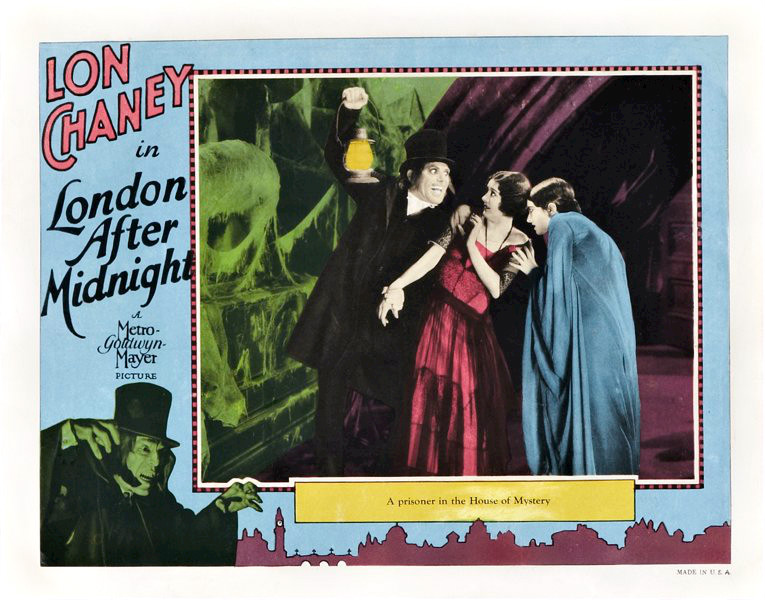
There were multiple novelizations and even a remake starring Bela Lugosi (who else?) in its own time period. But in present times, there have been many attempts at reconstruction, based on what we know of the film. In 1985, a photo reconstruction was published by Philip J. Riley, based on surviving production stills from MGM. In 2002, Rick Schmidlin produced a film reconstruction, based on the original script. In 2016, a book was published based on a compilation of surviving sources, entitled London After Midnight: A New Reconstruction Based on Contemporary Sources, and incorporated a previously undiscovered magazine essay from 1928. Additionally, the same book was updated with a second edition in 2018, after the discovery of a French novelization of the film.
Beyond the professional attempts, there are countless internet sleuths and film buffs constantly searching for a copy, checking various websites, and hitting “refresh” every few years. The YouTube comments are filled with hopeful fans, asking every rich person to scour the Earth and search their own personal archives for a copy.
So, what exactly has inspired so many to attempt the impossible: knowing exactly what was on that reel, which burned up in the fire? To answer that question, we will watch what did survive the fire. Clocking in at only eighteen minutes, the surviving film is currently available on YouTube.
We open with the credits, as most silent films did. Because all that we have to go on are stills, the film flashes between shots of actors frozen in terrified faces and poses. The recovered plot fills in the gaps: Roger Balfour is found dead one night, in London. Despite objections from close friend Sir James Hamlin, his death is ruled a suicide by the representative from Scotland Yard, a man named Edward C. Burke.
The film then flashes to five years later, where we are first introduced to the iconic villain who has stood the test of time and influenced so many since then: The Man in the Beaver Hat, portrayed by the legendary Lon Chaney. The Man in the Beaver Hat is accompanied by a pale, thin woman who will later appear to have bat-like features, influencing generations of vampire films in the years to come. Before we had the Scream Queens of the 1980s, we had the horror character actors, such as Bela Lugosi. But before we had Bela Lugosi, we had Lon Chaney. Chaney often portrayed grotesque or tortured characters. His iconic flashing eyes, sharp teeth, and beaver hat are perhaps the most well-known features of London After Midnight. His character has clearly influenced many villains, such as The Penguin in Batman Returns and the titular Babadook.
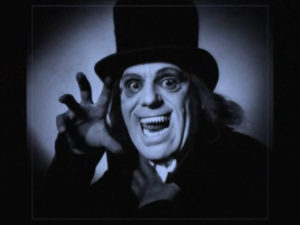
Five minutes in, we finally have our first dialogue. The word cards speak of “vampyrs,” the dead who rise from their graves at night to “feed upon the blood of the living.” Tres spooky!
The Man in the Beaver Hat is revealed to be Burke himself, the Scotland Yard representative who declared Balfour’s death a suicide five years earlier. We learn he did so in order to marry Balfour’s daughter. Balfour hypnotizes the group into believing it is five years earlier, recreates the night of the murder, and makes them believe Sir James was the killer.
I think these various elements are what makes London such a sought-after film. The popularization of the vampire in films, the classic Man in the Beaver Hat, who is really a bat himself, the pale female vampire, the hidden identity – horror buffs across multiple genres want to see the source itself, a huge piece of the horror genre origin puzzle. It also gave us a nasty ending, which has always been a fan favorite in horror movies. Though London did not create these elements per se, it did bring them to the silver screen and combined them in a new and innovative manner.
However, Lon Chaney himself may also be the greatest draw. Many cite him as a great influence, including actors, directors, and even writers. He was born to deaf parents and perfected the art of the pantomime in early childhood, which made for a great silent film star. He let us know you can scare your audience with body language alone. He took on many frightening roles, based on physical appearance and mannerisms, including the eponymous Phantom in The Phantom of the Opera, and The Hunchback of Notre Dame. He was troubled in his personal life, attempting suicide once (that we know of), and bouncing through marriages. He was also a talented makeup artist, doing his own, and inspiring many others. He frequently displayed his iconic makeup tray for cameras, and the tray was donated to the Natural History Museum of Los Angeles County. His ability to transform himself through acting, pantomime, and makeup earned him the nickname, “The Man of A Thousand Faces”.
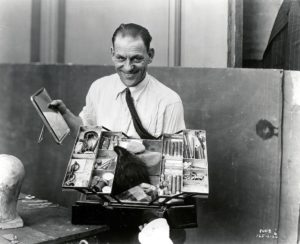
Ray Bradbury once stated:
“He was someone who acted out our psyches. He somehow got into the shadows inside our bodies; he was able to nail down some of our secret fears and put them on-screen. The history of Lon Chaney is the history of unrequited loves. He brings that part of you out into the open, because you fear that you are not loved, you fear that you never will be loved, you fear there is some part of you that’s grotesque, that the world will turn away from.”
(– A Thousand Faces, a documentary by Kevin Brownlow about Lon Chaney)
Though modern audiences would most likely not find this film scary, were it to be genuinely resurrected, it is inarguably delightful. One cannot help but love the facial expressions, the transformation of man to vampyr, the corrupt bureaucrats, the twist ending, and the sheer thrill of it all. Furthermore, there is something very powerful about seeing something that was so influential, the one that started it all.
Despite burning up in the 1965 fire, London After Midnight has clearly stood the test of time and continues to influence creators of all sorts nearly a century after its first release.
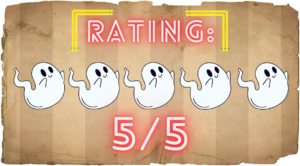
More Film Reviews
Arguably one of the most celebrated European exploitation subgenres, nunsploitation rose to prominence in the 1970s following The Devils in 1971. Largely driven by Italian productions such as Sister… Opening with an awkward family greeting before a Christmas Celebration, The Uncle is familiar to those who have pushed through awkward gatherings. However, the sinister undertone of the film is… Koji Shiraishi proves his sincerity and devotion to the found footage subgenre in his 2012 low-budget mockumentary Senritsu Kaiki File Kowasugi! File 01 – Operation Capture the Slit-Mouthed Woman. While… Toronto After Dark Film Festival describes Isaac Ezban’s latest as “possibly the scariest film in [their] lineup this year,” and it is not difficult to see why. Balancing storybook wonder… “A disoriented and frightened man awakens in a hospital room to discover he’s the recipient of a full face transplant. Plagued by weird flashbacks, no memory, and no visitors, he… In a previous article of mine, I mentioned the creation of found footage and incorrectly attributed this title to Eduardo Sánchez and Daniel Myrick’s The Blair Witch Project (1999). Although…The Virgin Witness (1966) Film Review – The Origins of Japanese Nunsploitation
The Uncle (2022) Film Review – The Best Family Traditions Are Forged Through Fear [Fantastic Fest]
Senritsu Kaiki File Kowasugi File 01: Operation Capture the Slit-Mouthed Woman (2012) Film Review—A Gem Hidden in Plain Sight
Evil Eye (2022) Film Review | Toronto After Dark Film Festival
Faceless (2021) Film Review – Who Are You Really?
The McPherson Tape (1989) Film Review – Guess Who’s Coming To Dinner
Voting member of the Independent Spirit Awards. Charter subscriber to the Criterion Channel. Silent and pre-code horror enthusiast. In my “real” life, I’m a human rights activist, social scientist, and burlesque performer
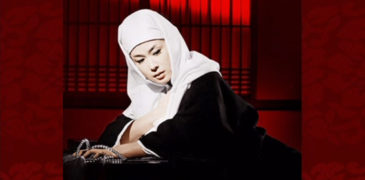
![The Uncle (2022) Film Review – The Best Family Traditions Are Forged Through Fear [Fantastic Fest]](https://www.grimoireofhorror.com/wp-content/uploads/2023/09/The-Uncle-2022-review-365x180.jpg)
